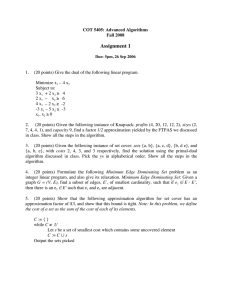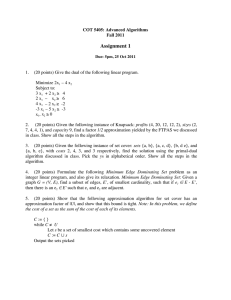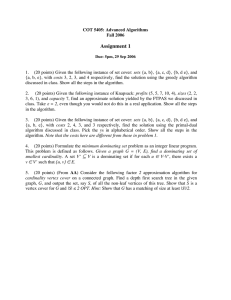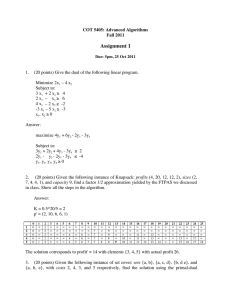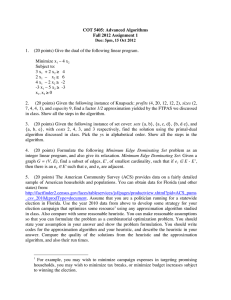starcover
advertisement
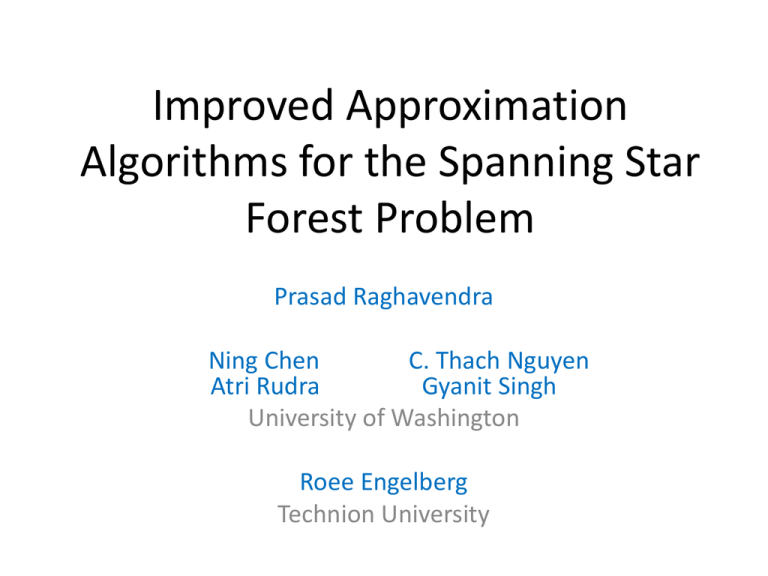
Improved Approximation Algorithms for the Spanning Star Forest Problem Prasad Raghavendra Ning Chen C. Thach Nguyen Atri Rudra Gyanit Singh University of Washington Roee Engelberg Technion University Star Forest Center A Star is a tree of diameter 2. A Star Forest is a forest consisting of only Stars Leaves (a bunch of vertex disjoint stars ) Unweighted Star Forest Problem Input : Undirected graph G 3 7 2 1 Find a Star Forest with the maximum number of edges 6 5 4 Number of Edges = 5 4 Equivalently, Maximize the number of leaves. Star Forest Problem Applications : • Problem of aligning multiple genomic sequences. [Nguyen .et. al, SODA2007] • Comparison of Phylogenic Trees. [Berry-Guillemot-Nicholas et. al 2005] • Diversity Problem in Automobile Industry. [Agra-Cardoso-Cerferia et. al 2005] Closely Related to the Dominating Set Problem Dominating Set A set of vertices S, such that 3 7 2 1 6 5 4 “Every vertex not in S is adjacent to a vertex in set S” Relation to Dominating Set 3 L = Set of Leaves 7 L = Set of NOT Leaves 1 Every vertex in L is adjacent to a vertex in L. 6 5 L is a Dominating Set 4 Maximum Star Forest = n – (Minimum Dominating Set) Our Results We give a 0.71 approximation algorithm for Unweighted star forest problem. – Improves the 0.6 factor in [Nguyen .et. al, SODA2007] New rounding scheme for Dominating Set that yields - approximation. Better than ln n when OPT is larger – Meets the best known algorithm by analysis of greedy algorithm [P. Slavik, Journal of Algorithms 1997] Our Results 0.64 approximation for the Node-weighted version. – Nodes have weights , Maximize the total weight of the leaves in the forest. Hardness of approximation results for the weighted versions of the problem. – 31/32 hardness for the node weighted version. – 0.95 hardness for the edge weighted version. Dominating Set - A Linear Program Variables : (x1, x2 ,… xn) xi = 1 if vertex i is in dominating set = 0 otherwise Constraints : For every vertex, at least one vertex in its neighbourhood belongs to the dominating set 2 Example : 1 3 4 x1 + x2 + x3 +x4 ≥ 1 Let the LP-OPT = a∙n Add vertex i in to the dominating set independently with probability : Rounding Scheme 3 7 Add any vertices still uncovered, to the dominating set. 2 1 6 5 4 Even if xi = 1, probability that it is included is < 1 Analysis STEP 1 : Add vertex i in to the dominating set independently with probability : Analysis STEP 2: Add any vertices still uncovered, to the dominating set. LP Constraint E[Number of Vertices added in STEP 2] ≤ ne-t Analysis Linear Programming OPT = a∙n Expected Size of Dominating Set = n(1–e-at) + ne-t Choosing the best value of t, We get a dominating set. - approximation for Not Enough Factor = LP OPT = a∙n Gives good approximation for Star Forest if OPT is closer to n If OPT is smaller, then gives poorer approximation. However if OPT is smaller, then there are simple algorithms that give good approximation. Simple Tree Algorithm 3 7 2 1 • Pick a spanning tree. • Root the tree at an arbitrary node. • Divide nodes in to levels based on distance from root. • Either the odd or the even levels have at least n/2 nodes. 6 5 4 Make these nodes leaves and other centers. A 0.64-Approximation Tree Algorithm: Finds a Star Forest of size at least n/2 So if LP OPT = a∙n A 1/2a approximation LP Algorithm: A approximation Best of the two algorithms , gives an approximation = 0.64 Getting to 0.7 We design a Combinatorial Algorithm for Unweighted Star Forest that gives -approximation. 3 5 a Using this along with LP algorithm gives : Conclusion Non linear LP rounding with probability : 1-e-tx Similar algorithms for Weighted Dominating Set, more generally Weighted Set Cover. Intuition? Any other applications? Thank You
